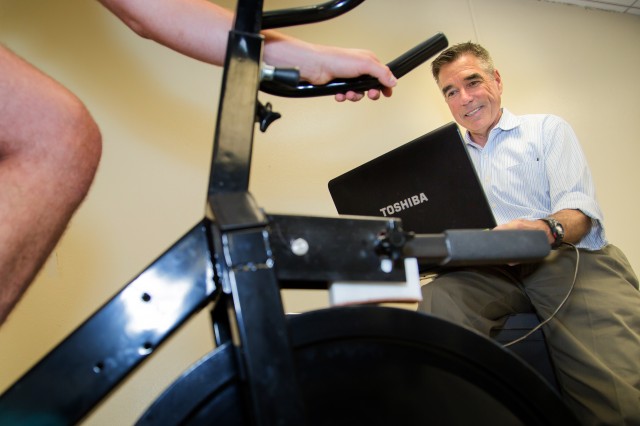Professor’s Invention Measures Athletes’ Peak Power

Professor Edward Coyle monitors the training of student athletes using his invention, the PowerCycle. Photo by Martin do Nascimento.
By Haoting Liang
For Reporting Texas
In four seconds, Edward Coyle can tell athletes a lot about their bodies.
The kinesiology professor at the University of Texas at Austin uses a device he invented to measure something called “maximal power,” which helps athletes understand their physical limits. The data Coyle collects tells him about the power athletes generate, whether they are overtraining and how long it takes them to recover from a workout.
The device, called the PowerCycle, looks like a stationary bicycle with a broad base and a solid flywheel. It’s connected to a computer that generates data.
The PowerCycle works like this: Athletes pedal as fast as they can for four seconds with no tension on the flywheel. Coyle uses the revolutions per minute they generate to calculate maximal power. The faster the wheel spins, the higher the maximal power. Coyle also incorporates a formula that involves the rate of acceleration.
Coyle allows athletes to rest for one minute between four trials of four minutes each. He then averages the top two results to determine the maximal power of the individual.
His work tells him about how athletes’ muscles work, when they are at risk of injury and if an athlete is weaker in one leg than the other.
“Because if you are overtraining, you can see the reduction in maximal power,” Coyle said.
Coyle has had a distinguished career at Texas. He received the Citation Award of the American College of Sports Medicine in 2006 and has been recognized as the foremost investigator in the field of exercise physiology. He is a consultant to sports teams such as the San Antonio Spurs and UT’s athletics program. He also has worked with the Chicago Blackhawks of the National Hockey League.
The UT women’s basketball team used the PowerCycle last season to measure players’ fatigue through the off-season, pre-season and post-season.
“The PowerCycle is important because it validates our visual assessment of a player’s physical performance when planning off-season workouts and practice volumes over the course of the season,” strength and conditioning coach Shaun McPherson said.
McPherson said the test lets him know how players respond to the demands of preparation, practice and games.
Coyle started measuring power in athletes in 1976. He invented an early prototype of his device in 1995.
Two years later, Coyle and two other researchers published a paper in a journal called Medicine and Science in Sports and Exercise. The six-page article validated his method as an accurate measurement of power.
Coyle founded a company to sell the PowerCycle to NASA and different sports teams. The business, however, is little more than a hobby, Coyle said.
The Texas women’s soccer team once used PowerCycle but no longer does.
“The previous coach, Chris Petrucelli, used it to determine how recovered his players were after two games over a weekend,” said Lisa Stalans, who formerly coached Texas soccer and now is an associate athletic trainer with the women’s basketball team.
“He used the results to gauge how many minutes players should be in the game.”